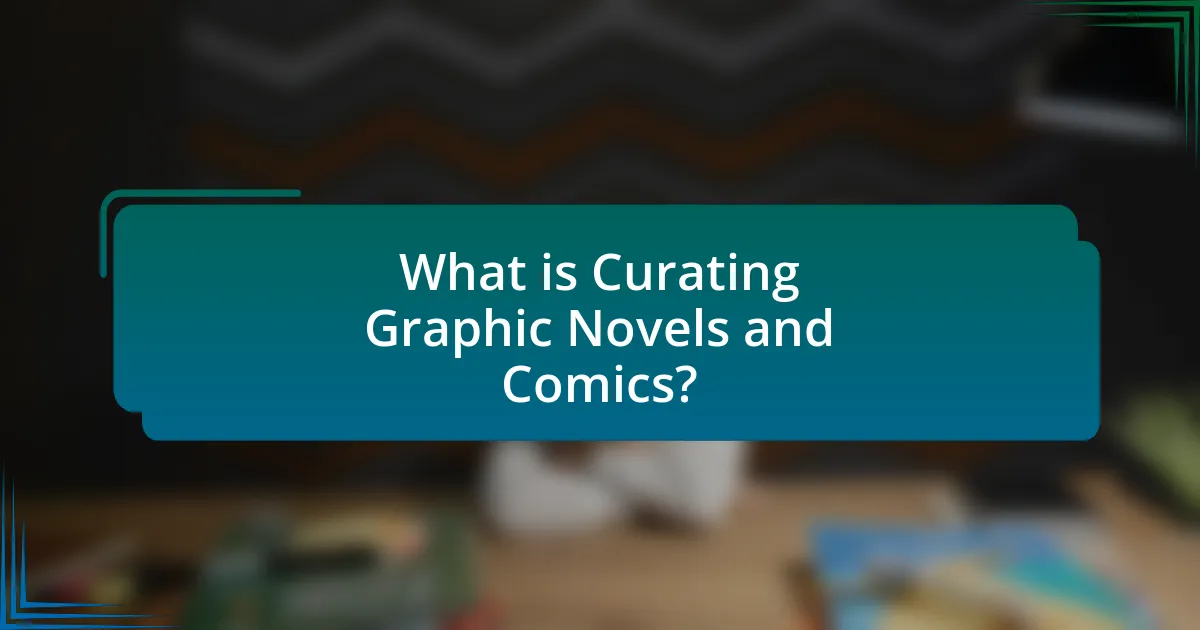Curating graphic novels and comics is a critical process for independent bookstores, involving the selection, organization, and presentation of works that reflect specific themes and artistic styles. This article explores the curation process, highlighting the importance of understanding audience preferences, market trends, and community engagement. Key elements such as selection criteria, thematic organization, and display techniques are discussed, along with the unique advantages curated collections offer to independent bookstores. Additionally, the article addresses challenges faced in curation, strategies for effective selection, and the role of local community involvement in enhancing the customer experience.

What is Curating Graphic Novels and Comics?
Curating graphic novels and comics involves the selection, organization, and presentation of these works to create a cohesive collection that reflects specific themes, genres, or artistic styles. This process is essential for independent bookstores as it helps them differentiate their offerings, attract niche audiences, and foster a deeper appreciation for the medium. Curators often consider factors such as storytelling quality, artistic merit, and cultural significance when choosing titles, ensuring that the collection resonates with readers and enhances their experience.
How does the curation process work for graphic novels and comics?
The curation process for graphic novels and comics involves selecting, organizing, and presenting works that align with the target audience’s interests and the bookstore’s identity. Curators typically evaluate titles based on factors such as artistic quality, storytelling, and cultural relevance, often considering reader demographics and current trends in the graphic novel market. For instance, independent bookstores may prioritize diverse voices and unique narratives to differentiate their offerings from larger retailers. This process often includes soliciting recommendations from publishers, attending industry events, and engaging with the community to understand preferences. The effectiveness of this curation is supported by the growing demand for graphic novels, which saw sales increase by 25% in 2020, indicating a robust market for thoughtfully curated selections.
What are the key elements involved in curating graphic novels and comics?
The key elements involved in curating graphic novels and comics include selection criteria, audience understanding, thematic organization, and display techniques. Selection criteria involve evaluating the quality of artwork, storytelling, and originality, ensuring that the curated works resonate with both critical acclaim and reader interest. Audience understanding requires knowledge of the target demographic’s preferences, which can be informed by sales data and community feedback. Thematic organization helps in grouping titles by genre, style, or subject matter, facilitating easier navigation for customers. Display techniques, such as strategic placement and signage, enhance visibility and engagement, ultimately driving sales. These elements collectively contribute to a well-rounded and appealing collection that meets the needs of independent bookstores and their clientele.
How do independent bookstores select titles for their collections?
Independent bookstores select titles for their collections through a combination of customer preferences, market trends, and personal curation by staff. They often engage with their local community to understand reading interests, which informs their purchasing decisions. Additionally, many independent bookstores attend industry events, such as book fairs and author signings, to discover new titles and connect with publishers. This approach allows them to curate a diverse selection that reflects both popular demand and unique, lesser-known works, ensuring a well-rounded inventory that appeals to their customer base.
Why is curation important for independent bookstores?
Curation is important for independent bookstores because it allows them to differentiate themselves in a competitive market by offering a carefully selected range of titles that reflect their unique identity and cater to specific customer interests. This tailored selection enhances the shopping experience, fosters customer loyalty, and encourages repeat visits, as customers are more likely to return to a store that understands their preferences. Additionally, effective curation can highlight lesser-known authors and niche genres, such as graphic novels and comics, which may not receive attention in larger retail chains, thus supporting diverse voices in literature and promoting a vibrant literary community.
What unique advantages do curated collections offer to independent bookstores?
Curated collections provide independent bookstores with the unique advantage of differentiating their offerings from larger retailers, thereby attracting a dedicated customer base. By selecting specific themes or genres, such as graphic novels and comics, independent bookstores can create a personalized shopping experience that resonates with niche audiences. This targeted approach not only fosters community engagement but also enhances customer loyalty, as shoppers are more likely to return for specialized selections that reflect their interests. Additionally, curated collections can lead to increased sales, as they often highlight lesser-known titles that may not receive attention in mainstream outlets, thus supporting diverse authors and creators.
How does curation enhance the customer experience in bookstores?
Curation enhances the customer experience in bookstores by providing a tailored selection of books that aligns with specific interests and preferences. This personalized approach helps customers discover titles they may not have found on their own, fostering a deeper connection to the material. For instance, independent bookstores often curate graphic novels and comics based on themes, genres, or local authors, which can create a unique shopping experience that reflects the community’s culture. Research indicates that curated selections can increase customer satisfaction and loyalty, as shoppers feel more engaged and valued when they encounter thoughtfully chosen content that resonates with their tastes.

What challenges do independent bookstores face in curating graphic novels and comics?
Independent bookstores face several challenges in curating graphic novels and comics, primarily due to limited shelf space and the vast array of titles available. The sheer volume of graphic novels and comics published annually, estimated at over 1,000 new titles each year, makes it difficult for these stores to select which ones to stock. Additionally, independent bookstores often operate on tight budgets, restricting their ability to invest in a diverse inventory that reflects the interests of their customer base. Market competition from larger retailers and online platforms further complicates their ability to attract customers, as these competitors can offer lower prices and a wider selection. Furthermore, independent bookstores may lack access to comprehensive market data, making it challenging to identify trends and customer preferences in the graphic novel and comic market.
How do market trends impact the curation of graphic novels and comics?
Market trends significantly influence the curation of graphic novels and comics by guiding the selection of titles that align with consumer preferences and sales data. For instance, the rise in popularity of diverse narratives and representation has led curators to prioritize graphic novels that feature underrepresented voices, reflecting a broader societal demand for inclusivity. Additionally, sales trends indicate that genres such as fantasy and horror have seen increased consumer interest, prompting bookstores to stock more titles within these categories. According to a 2022 report by NPD Group, graphic novel sales in the U.S. reached over $1.28 billion, highlighting the importance of aligning curation strategies with market dynamics to meet consumer demand effectively.
What are the current trends in graphic novels and comics that bookstores should consider?
Current trends in graphic novels and comics that bookstores should consider include the rise of diverse storytelling, with a focus on representation of various cultures, identities, and experiences. This trend is supported by the increasing popularity of graphic novels that feature LGBTQ+ characters and narratives, as well as stories from marginalized communities, which have seen significant sales growth. Additionally, there is a notable shift towards graphic memoirs and autobiographical works, reflecting personal experiences and societal issues, which resonate with readers seeking authenticity. The graphic novel market has also expanded to include more young adult and children’s titles, driven by the success of series like “Dog Man” and “Amulet.” Furthermore, the integration of digital formats and webcomics is influencing print sales, as readers engage with content across multiple platforms. These trends indicate a dynamic market that values inclusivity, personal storytelling, and adaptability to new media.
How can independent bookstores adapt to changing consumer preferences?
Independent bookstores can adapt to changing consumer preferences by curating a diverse selection of graphic novels and comics that reflect current trends and interests. This approach allows them to cater to a growing demographic that increasingly values visual storytelling, as evidenced by the graphic novel market’s significant growth, which reached over $1.2 billion in sales in 2020, according to the NPD Group. By hosting events such as author signings, book clubs, and workshops focused on graphic novels, independent bookstores can create community engagement and foster a loyal customer base. Additionally, leveraging social media platforms to promote new releases and engage with readers can further align their offerings with consumer preferences.
What role does community engagement play in curation?
Community engagement plays a crucial role in curation by fostering a deeper connection between curators and their audience, particularly in the context of graphic novels and comics. Engaging with the community allows curators to understand local interests, preferences, and cultural nuances, which informs their selection of titles and themes. For instance, independent bookstores that actively involve their customers in discussions or events often see increased sales and customer loyalty, as evidenced by studies showing that community-driven initiatives can boost foot traffic and enhance the overall shopping experience. This interaction not only enriches the curation process but also ensures that the curated content resonates with the community’s values and interests.
How can independent bookstores involve their local communities in the curation process?
Independent bookstores can involve their local communities in the curation process by hosting community events such as book clubs, author readings, and workshops that encourage local input on book selections. These events create a platform for community members to share their preferences and recommendations, fostering a sense of ownership and connection to the bookstore’s offerings. For instance, a study by the American Booksellers Association found that independent bookstores that actively engage with their communities through events see a 20% increase in customer loyalty and sales. This demonstrates that community involvement not only enriches the curation process but also enhances the bookstore’s overall success.
What events or activities can bookstores host to promote their curated collections?
Bookstores can host author signings, themed book clubs, and graphic novel workshops to promote their curated collections. Author signings create direct engagement with readers and can attract fans of specific genres, while themed book clubs encourage community discussions around selected titles, fostering a deeper appreciation for the curated works. Graphic novel workshops provide hands-on experiences, allowing participants to explore storytelling and illustration techniques, which can enhance interest in the curated graphic novels. These activities not only draw in customers but also build a loyal community around the bookstore’s offerings.

What strategies can independent bookstores use for effective curation?
Independent bookstores can use targeted selection, community engagement, and thematic displays for effective curation. Targeted selection involves choosing graphic novels and comics that resonate with local interests and demographics, ensuring relevance and appeal. Community engagement can be achieved through hosting events, author signings, and book clubs, which fosters a loyal customer base and encourages feedback on curation choices. Thematic displays, such as organizing titles by genre, artist, or cultural themes, enhance visibility and create a more immersive shopping experience. These strategies are supported by studies indicating that personalized curation increases customer satisfaction and sales in independent bookstores.
How can independent bookstores build relationships with publishers and creators?
Independent bookstores can build relationships with publishers and creators by actively engaging in collaborative events, such as author signings and book launches, which foster direct connections. These events not only promote the creators’ works but also enhance the bookstore’s visibility within the literary community. Additionally, independent bookstores can establish regular communication with publishers through newsletters and social media, sharing insights on customer preferences and sales trends, which can lead to tailored support from publishers. Research indicates that bookstores that maintain strong partnerships with publishers often receive exclusive access to new titles and promotional materials, enhancing their inventory and customer offerings.
What are the benefits of collaborating with local artists and authors?
Collaborating with local artists and authors enhances community engagement and fosters a unique cultural identity. This partnership allows independent bookstores to offer exclusive content, such as locally themed graphic novels and comics, which can attract a dedicated customer base. Additionally, showcasing local talent can lead to increased foot traffic and sales, as customers often seek to support their community. Research indicates that businesses that engage with local artists can experience a 20% increase in customer loyalty, as consumers value local connections and authenticity.
How can bookstores leverage social media for curation and promotion?
Bookstores can leverage social media for curation and promotion by creating engaging content that showcases their graphic novels and comics selection. By utilizing platforms like Instagram and Facebook, bookstores can post visually appealing images of new arrivals, staff picks, and themed collections, which attract potential customers.
For instance, a study by the Pew Research Center indicates that 69% of adults use social media, making it an effective channel for reaching a broad audience. Additionally, bookstores can host virtual events, such as author Q&As or live readings, to engage their community and promote specific titles. This interactive approach not only enhances customer relationships but also drives sales by highlighting unique offerings in the graphic novel and comic niche.
What best practices should independent bookstores follow in curation?
Independent bookstores should prioritize diverse representation and community engagement in their curation practices. By selecting graphic novels and comics that reflect various cultures, identities, and experiences, bookstores can cater to a broader audience and foster inclusivity. Engaging with local communities through events, author signings, and discussions can also enhance the curation process, as it allows bookstores to understand customer preferences and interests. Research indicates that bookstores that actively involve their communities in curation see increased customer loyalty and sales, as they create a space that resonates with local readers.
How can bookstores create a diverse and inclusive graphic novel and comic selection?
Bookstores can create a diverse and inclusive graphic novel and comic selection by actively sourcing titles from a wide range of authors and artists representing various backgrounds, cultures, and identities. This approach ensures that the selection reflects the diversity of the community and the broader society. For instance, bookstores can partner with publishers that specialize in underrepresented voices, such as those focusing on LGBTQ+ narratives, stories from marginalized communities, or works by authors of color. Additionally, hosting events like author signings, panels, and discussions can promote awareness and engagement with diverse graphic novels and comics. Research indicates that diverse representation in literature can enhance empathy and understanding among readers, making it crucial for bookstores to prioritize inclusivity in their offerings.
What methods can bookstores use to evaluate the success of their curated collections?
Bookstores can evaluate the success of their curated collections through sales data analysis, customer feedback, and inventory turnover rates. Sales data analysis provides quantitative insights into which titles are performing well, allowing bookstores to identify popular genres or authors. Customer feedback, gathered through surveys or direct interactions, offers qualitative insights into customer preferences and satisfaction levels regarding the curated selections. Additionally, monitoring inventory turnover rates helps bookstores understand how quickly items are selling, indicating the effectiveness of their curation strategy. These methods collectively enable bookstores to make informed decisions about future collections and adjustments to their offerings.
What are some practical tips for curating graphic novels and comics?
To effectively curate graphic novels and comics, focus on understanding your target audience’s preferences and current trends in the genre. Research popular titles and emerging authors to ensure a diverse selection that appeals to various tastes. Incorporate a mix of classic and contemporary works to provide a well-rounded collection. Engage with local comic communities and attend conventions to gain insights and recommendations. Additionally, consider thematic displays or curated sections that highlight specific genres, artists, or cultural movements, enhancing the browsing experience. This approach is supported by the growing interest in graphic storytelling, as evidenced by the increasing sales of graphic novels, which reached over $1 billion in the U.S. market in 2020, according to the NPD Group.


